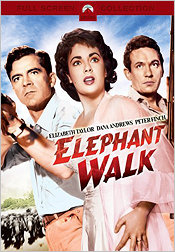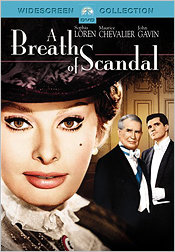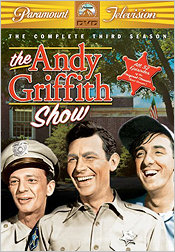 |
Site created 12/15/97.

page created: 11/14/05
 Barrie Maxwell - Main Page |
| Classic
Reviews Roundup #24 - November 2005 Catching Up with Paramount A short while ago, I devoted one of these columns to recent classic releases by Fox. Now it's time to do the same catch-up with Paramount who also have been releasing classic product with too little fanfare. Using the end of 1971 as an arbitrary cut-off date, theatrical or television releases originating before that time that Paramount has brought to DVD during the July-to-October number some 25 titles. That's not quite as impressive as Fox's efforts during the May-to-September period, but then, unlike Fox, Paramount has virtually no access to its pre-1950 titles (those being currently controlled by Universal). I suspect few people can list the titles of more than a handful of these 25 releases. Only the appearance of four films originating with John Wayne's own production company (The High and the Mighty, Island in the Sky, Hondo, McLintock!) and perhaps Preston Sturges' The Miracle of Morgan's Creek have made any great splash at all. One reason that Paramount's product often gets dismissed is its failure to include any supplementary material on the majority of its classic discs (unlike Warner Bros. and to a lesser extent Fox). That's a poor excuse for overlooking the product though, for the transfers (which are the most important characteristic of any disc) are as a rule superior and the pricing is very reasonable. And even when supplements are included, the latter remains true. July Releases Paramount's July offerings comprised six films that all contained significant star power: Candace Bergen and Ernest Borgnine in The Adventurers (1970), Lana Turner and Sean Connery in Another Time, Another Place (1958), Sophia Loren and Maurice Chevalier in A Breath of Scandal (1960), Elizabeth Taylor and Dana Andrews in Elephant Walk (1954), Clark Gable and Sophia Loren in It Started in Naples (1960), and Burt Lancaster and Katharine Hepburn in The Rainmaker (1956). Unfortunately, only the latter was really a very good film, the rest mainly highlighting players either before or after much of their best work. Reviews of all titles follow, except for It Started in Naples, which I previously reviewed in my August 4th, 2005 column. The reviews are ordered by year of original theatrical release. |
| The
DVD presentation is full frame, which is probably correct although
the framing suggests that the film could also have been adapted to
the wider screens being introduced at the time. There's noticeable
source material damage and the contrast is not always what it could
be, but the colour is generally very bright and well saturated. The
mono sound is clear although subject to some minor hiss. There are
English subtitles, but no supplementary material. Well worth a
rental. |
| Lancaster
and Hepburn enjoyed working together and the resulting chemistry
generated two superb performances. Lancaster particularly succeeds
with a wonderful blend of braggadocio one minute (reminiscent of his
later Elmer Gantry work) and
tender solicitude the next. Hepburn was considered miscast by virtue
of her age and eastern upbringing by some critics of the time, but
she seems well in tune with her part to these eyes. The Academy
agreed and accorded her a Best Actress nomination for her work
(although she lost out to Ingrid Bergman for Anastasia).
The Rainmaker does not belie
its stage origins as the studio didn't see fit to spring for any
location work that might have opened things up a bit, but the
principal players' work is so good that one soon forgets that
deficiency. Paramount's 1.85:1 anamorphic transfer of the VistaVision picture is quite decent. There is some variation both in image intensity and colour vibrancy, but for the most part it looks fine. Speckling and scratches are noticeable at times. The mono sound is fully adequate for this dialogue-driven film. A French mono track and English subtitles are also provided. There are no supplements. Recommended. |
| The
1.85:1 anamorphic transfer is first rate with a nicely detailed and
glowing black and white image. The mono sound is workmanlike and
supplemented by English subtitles. There is no bonus material.
Recommended as a rental. |
| Paramount's
1.85:1 anamorphic transfer is bright, fairly sharp, and for the most
part does justice to the Technicolor film. Colour fidelity is good
while there is minor grain in evidence at times. The mono sound is
in fine shape, offering some presence in the musical interludes.
English subtitles are provided, but there are no supplements. |
|
Unfortunately it all goes on for three interminable hours. Someone
named Bekim Fehmiu plays Dax and demonstrates no acting ability
whatsoever. Others that have ability are wasted, especially Ernest
Borgnine, Candace Bergen, Charles Aznavour, and Leigh Taylor-Young.
I've heard some say that the film is a guilty pleasure. Guilty, yes!
Pleasure, no! Paramount presents it in a 2.35:1 anamorphic transfer that looks fine - fairly crisp, good colour, some grain in evidence. There are various speckles and scratches to be seen. Dolby Digital 5.1 and 2.0 surround tracks are provided and both do the job. That is, you can hear things clearly, unfortunately. On the plus side, there are no supplements. August Releases This month's releases were highlighted by the appearance of the first two John Wayne produced films to which Paramount recently acquired the home video rights - the much anticipated The High and the Mighty and also Island in the Sky. Also made available was 1971's The Red Tent while Paramount continued working through the various seasons of the ever-popular TV series, I Love Lucy and The Andy Griffith Show. Reviews of all titles follow except for The High and the Mighty, which I reviewed in my August 4th, 2005 column and recommended. |
| Among
those familiar faces are the likes of Lloyd Nolan, Andy Devine,
Harry Carey Jr., Walter Abel, James Arness, Allyn Joslin, Regis
Toomey, and Paul Fix. Direction is by the veteran William Wellman, a
man with a long-time interest in aviation, who makes the film's
109-minute running time race by. Paramount's Special Collector's Edition DVD presents the black and white film full frame as originally released. The source material has been restored and is in great shape yielding an excellent transfer - deep blacks, clean whites and good image detail. There is some mild grain in evidence at times. The mono sound has also been cleaned up and provides clear dialogue. English subtitles are also provided. The supplements begin with a short introduction to the film by Leonard Maltin. He then participates in a very entertaining and informative audio commentary that also involves William Wellman Jr., aviation consultant Vincent Longo, and actors Darryl Hickman and James Lydon. The making of the film is documented in three parts: Dooley's Down - The Making of Island in the Sky; Ernest K. Gann - Adventurer, Author & Artist; and Flight School - The Art of Aerial Cinematography. Additional supplements include an interview with Harry Carey Jr., some background on the Army Transport Command, newsreel footage of the film's premiere, a photo gallery, the original theatrical trailer, and an Introduction to Gunsmoke TV promo. Recommended. |
| Lucille
Ball was in top form as ever with her impeccable timing, facial
expressions, and excellent comic delivery all in evidence. The
ensemble work with Desi Arnaz, Vivian Vance, and William Frawley was
by now so comfortable that it was like a visit with close family for
the audience every week. The fifth season includes some of the series' most memorable episodes including Lucy stealing some cement footprints from Grauman's Chinese Theatre (Lucy Visits Grauman's and Lucy and John Wayne), her predilection for pulling a train's emergency brake cord (The Great Train Robbery), her frenzied efforts to board the trans-Atlantic liner she's missed (Bon Voyage), modeling a French "gown" (Lucy Gets a Paris Gown), trying to smuggle cheese by wrapping it up like a baby (Return Home from Europe), and the famous grape stomping fiasco (Lucy's Italian Movie). Paramount continues its fine work on the Lucy season releases in conjunction with CBS DVD. This fifth season has 26 episodes that are spread over four discs. The individual episodes are complete except for one (Lucy and the Dummy), which has been edited from its original network version. The full frame images are crisp and clear with excellent shadow detail and generally betray few defects other than the odd speckle and scratch. The mono sound is in good shape and is free of all but the occasional patch of hiss. English closed captions and Spanish subtitles are provided, while Spanish mono tracks also accompany many episodes. The supplements which we've become accustomed to on the I Love Lucy sets are once again present: flubs, lost scenes, "behind-the-scenes" featurettes, original series openings, script excerpts, production notes, guest cast information, and several complete episodes of Lucy's radio show "My Favorite Husband". Recommended. |
| Potential
purchasers should note that Paramount provides a warning on the
packaging that some episodes are edited from their original network
versions. Barney Mends a Broken Heart
and The Darlings Are Coming,
each of which have truncated endings, appear to be two of the
episodes so affected. The latter (an episode in the public domain)
also has noticeably poorer image quality than all the others. The Season Three box set contains the 32 episodes on five discs packaged in three thinpack discs. The only supplement comprises original sponsor spots for a number of the episodes. The Andy Griffith shows are ones with a timeless quality and very repeatable entertainment value. Recommended. |
| The
scenes of the Arctic are particularly well done. Peter Finch carries
the film on his shoulders, giving a wonderful performance as Nobile.
Connery's scenes are limited, although he does play a significant
part in the resolution of the framing scenes. Also noteworthy is the
work of Hardy Kruger as a mercenary aviator who seeks the glory of
saving Nobile from his Arctic fate. The film's examination of the
responsibilities of leadership is one of its strengths. Some sources
list the film's original running time as being from 30 to 60 minutes
longer than the 121-minute international release version that
appears on the DVD. What the potential extra hour of footage may
have included is unclear, but perhaps more of the event's historical
context, especially the aftermath elaborating on the details of
Nobile's subsequent fate, may have been covered. Paramount's 1.85:1 anamorphic transfer is a sub-par effort for the studio. The image frequently lacks real sharpness and colours are rather muted, even allowing for the whites and grays of the Arctic setting. There is noticeable dirt and debris. A Dolby Digital 5.1 sound mix is offered but it's merely workable and doesn't really allow Ennio Morricone's fine score to shine. A 2.0 surround track and English subtitles are also provided. Disappointingly for this type of film, there are no supplements. Still, the compelling nature of the film's subject matter make a rental well worthwhile. |
On to Part Two
Barrie Maxwell - Main Page
 |
| Site
designed for 1024 x 768 resolution, using 16M colors and .gif 89a
animation. © 1997-2015 The Digital Bits, Inc., All Rights Reserved. billhunt@thedigitalbits.com |









